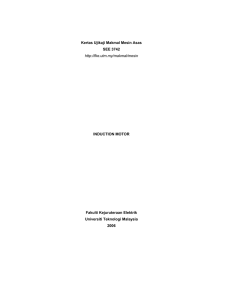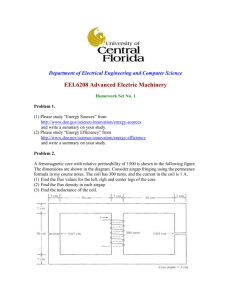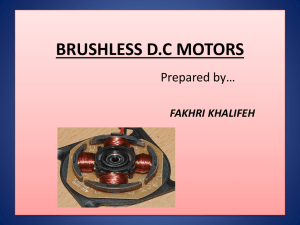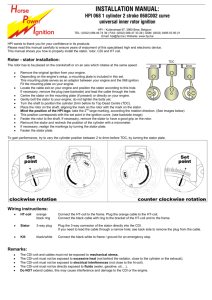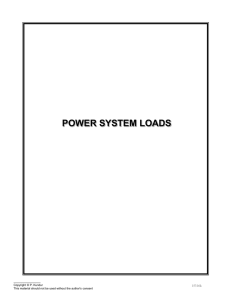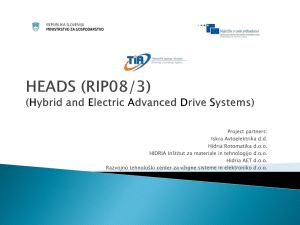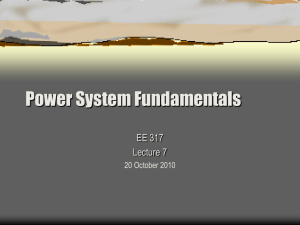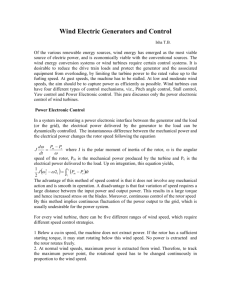Equivalent Circuit Model
advertisement
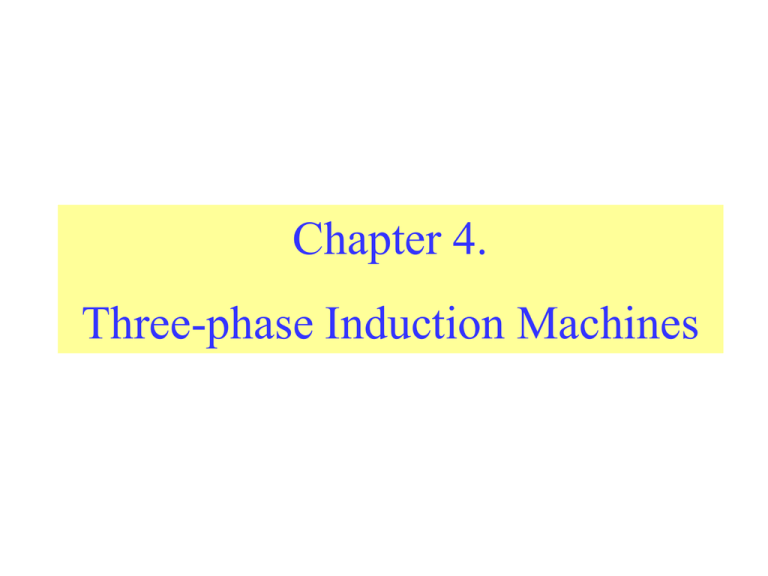
Chapter 4. Three-phase Induction Machines Introduction The induction machine is the most rugged and the most widely used machine in industry. Both stator and rotor winding carry alternating currents. The alternating current (ac) is supplied to the stator winding directly and to the rotor winding by induction – hence the name induction machine. Application (1-phase): washing machines, ceiling fans, refrigerators, blenders, juice mixers, stereo turntables, etc. 2-phase induction motors are used primarily as servomotors in a control system. Application 3-phase: pumps, fans, compressors, paper mills, textile mills, etc. Induction Machine Construction Construction Unlike dc machines, induction machines have a uniform air gap. The stator is composed of laminations of high-grade sheet steel. A three-phase winding is put in slots cut on the inner surface of the stator frame. The rotor also consists of laminated ferromagnetic material, with slots cut on the outer surface. Squirrel-cage Rotor Wound Rotor Slip ring Wound rotor Construction Cross-sectional view Y-connected stator -connected stator The three-phase winding are displaced from each other by 120 electrical degrees in space Current flows in a phase coil produce a sinusoidally distributed mmf wave centered on the axis of the coil. Alternating current in each coil produces a pulsating mmf wave. Mmf waves are displaced by 120 degrees in space from each other. Resultant mmf wave is rotating along the air gap with constant peak. Induction Motor Operation RMF – rotating magnetic field Rotating Magnetic Field – consider 2-pole machine a) b) Three phase stator winding, aa’, bb’ and cc’ displaced by 120o. Mmf (pulsating) in space at various instants due to a.c current in coil aa’ c) Instantaneous 3 phase current a. Graphical Method – Resultant mmf (magnitude and direction) Resultant mmf Mmf phase a at t = t0= t4 Graphical Method Constant amplitude, move around the air gap n = synchronous speed rpm Synchronous speed in rad/s 1 e p 2f1 rads-1 ; p pole pairs p f = f1= supply freq., p = no of poles b. Analytical Method Motion of the resultant mmf N = effective number of turns ia= current in phase ‘a’ Analytical Method Induced Voltages A where r = radius of the stator; = axial length of stator Induced Voltages V per phase At Standstill operation E = 4.44f N Kw E = 4.44f N Kw ; f = f 1 1 2 1 2 p 2 2 1 2 2 p E = 4.44f N Kw p 1 2 1 2 Running Operation pn f 120 at slip s * E2 – induced rotor voltage at standstill Can be reprensented in rads-1 e s m 2 ; s ; s s p s s m (1 s )s where : s : synchronous frequency e : supply frequency m : rotorfrequency p : pole pair 2 : slip frequency Example 1 A three-phase, 100 hp, 460 V, four-pole, 60 Hz induction machine delivers rated output power at a slip of 0.05. Determine the (a) Synchronous speed and motor speed. (b) Speed of the rotating air gap field. (c) Frequency of the rotor circuit. (d) Slip frequency (in rpm). (e) Speed of the rotor field relative to the (i) rotor structure (ii) stator structure (iii) stator rotating field (f) Rotor induced voltage at the operating speed, if the stator-to-rotor turns ratio is 1:0.5 Pg 219: 1800 &1710rpm, 1800rpm, 3 Hz, 90 rpm, (90rpm, 1800rpm, 0rpm), 6.64 V/ph) Sol_pg21 Equivalent Circuit Model • To study and predict the performance of the induction machine Equivalent Circuit Model Equivalent Circuit Model Equivalent Circuit Model Stator voltage equation: V1 = R1 I1 + j(2f)LlI1 + Eag; Eag – air gap voltage or back e.m.f Eag = E1 = k f1 ag Rotor voltage equation: E2 = R2 I2 + js(2f)Ll2 E2 = k f2 ag = k sf1 ag = sE1 E2 – induced emf in rotor circuit ; E1=R2/sI2+j2fLI2 Induction Motor Drives SEE4433 Dr Zainal / Dr Awang 25 Equivalent Circuit Model sE2 – rotor voltage at standstill Equivalent Circuit Model This model is not convenient to use to predict circuit performance Equivalent Circuit Model Example 2 A three-phase, 15 hp, 460 V, four-pole, 60 Hz, 1728 rpm induction motor delivers full output power to a load connected to its shaft. The windage and friction loss of the motor is 750 W. Determine the (a) mechanical power (b) air gap power (c) rotor copper loss. Pg 226: 11940 W, 12437.5 W, 497.5 W Sol_pg29 Equivalent Circuit Model Assume small volt drop across R1 and X1 – ease computation of I and I2’, V1 = E1 Due to machine air gap, I is high- 3050% of full –load current, X1 is high, core loss (Rc) is lumped into the mechanical losses Equivalent Circuit Model For simplification, replace V1, R1,X1, Xm with Vth, Rth, Xth ( at terminal Pag) R12<<(X1+Xm)2 X1 << Xm Equivalent Circuit Parameters Rc, Xm, R1, X1, X2, R2 No-Load Test The parameters of the equivalent circuit, Rc, Xm, R1, X1, X2, and R2 can be determined from the results of a noload test, a blocked-rotor test and from measurement of the dc resistance of the stator winding. The no-load test, like the open circuit test on a transformer, gives information about exciting current and rotational losses. This test is performed by applying balanced polyphase voltages (415V) to the stator windings at the rated frequency(50Hz). The rotor is kept uncoupled from any mechanical load. I1 R1 X1 Xm At no load, N r N s Ns N r s 0; Ns R2 R2 open cct s 0 Blocked-Rotor Test The blocked-rotor test, like the short-circuit test on a transformer, gives information about leakage impedances. In this test the rotor is blocked so that the motor cannot rotate, and balanced polyphase voltages are applied to the stator terminal ( increases voltage until stator current reaches its rated value). The blocked-rotor test should be performed under the same conditions of rotor current and frequency that will prevail in the normal operating conditions. The IEEE recommends a frequency of 25% of the rated frequency for the blocked-rotor test. However, for normal motors of less than 20 hp rating, the effects of frequency are negligible and the blocked-rotor test can be performed directly at the rated frequency R1 X1 X2 R2 At full load (block rotor test), N r 0; Ns N r s 1; Ns R2 R2 R 2 R2 X m , X m open cct s 1 Equivalent Circuit Parameters Measurement of average dc resistance per stator phase : R1 No load test : VNL INL PNL Blocked-rotor test: VBL INL PNL Example 3 The following test results are obtained from a three-phase, 60 hp, 2200 V, six-pole, 60 Hz squirrel-cage induction motor. No-load test: supply frequency = 60 HZ line voltage = 2200 V line current = 4.5 A input power = 1600 W Blocked-rotor test: frequency = 15 Hz line voltage = 270 V line current = 25 A input power = 9000 W Average DC resistance per stator phase: R1 = 2.8 ohm (a) Determine the no-load rotational loss. (b) Determine the parameters of the IEEE-recommended equivalent circuit. (c) Determine the parameters (Vth, Rth, Xth) for the thevenin equivalent circuit. Pg: 230: 1429.9 W Sol_pg38(IM) Performance Characteristics Performance calculation using SPEC I1 R1 L1 I2 Rm V1 Input Power : L2 R2 S Lm Pin 3V1I1 cos Note : V1 and I1 must be phase voltage and current Stator copper loss : Core loss : Power across the air - gap : Rotor copper loss : Pls 3I12 R1 3V12 Plc Rm 3I 2 2 R2 Pg s Pin Pls Plc Plr 3I 2 2 R2 Induction Motor Drives SEE4433 Dr Zainal / Dr Awang 40 Gross out put power : Po Pg Plr 3I 2 R2 3I 2 R2 (1 s ) 2 3I 2 R 2 Pg (1 s ) s s 2 2 P ower at t heshaft : Psh Po PFW ; PFW : frictionand windage loss. Developed(elect romagnetic) t orque: 3I 2 (1 s ) R2 Te m m s Po 2 Since s 1 m m (1 s )1 , 1 2 3I 2 R2 Te 1 s But 1 e p ; e is t hesupply frequency. T hen, Te 3 pI2 e 2 R2 s Example A single phase equivalent circuit of a 6-pole SCIM that operates from a 220 V line voltage at 60 Hz is given below. Calculate the stator current, input power factor, output power, torque and efficiency at a slip of 2.5%. The fixed winding and friction losses is 350 W. Neglect the core loss. Also calculate the starting current. I1 R1 X1 0.2 0.5 V1 Solution V1 220V line-to line 3 220V 127V 3 2.5% 0.025 I2 X2 0.2 Xm R2 20 0.1 X 1 0.5, X 2 0.2, X m 20 R Z in ( R1 jX 1 ) jX m // 2 jX 2 s 0.1 j 0. 2 4.220o 0.2 j 0.5 j 20 0.025 0 . 1 j 0.2 j 20 0.025 I1 V1 220 3 30.0 20o A o Z in 4.220 Pin 3V1 I1 cos 3(220 3 )(30)(cos20o ) 10,758W Pls 3I1 R1 3(302 )(0.2) 540W 2 P ower transferred to rotor(neglecting core loss) Pg Pin Pls 10,758 540 10,216W Gross power Po Pg (1 s ) 10,216(1 0.025) 9,961W P ower at theshaft Psh Po PFW 9,961 350 9,611W Output power 9611 89.3% Input power 10758 Electromagnet icT orque P Po 9611 Te o m (e1 p ) (1 s ) 2 (60 / 3)(1 0.025) Efficiency 78.4 N .m Input power factor Solution : At standstill , s 1 0.1 j 0.2 Z in 0.2 j 0.5 j 20 0 . 1 j 0 . 2 j 20 0.76 V 220 3 I1 1 167 A Z in 0.76 Note that the starting current is about 5 times than full load current. This is common for induction motors.Care should be taken when starting induction motors. Example The following results were obtained on a 3 phase, star connected stator, 75 kW, 3.3 kV, 6-pole, 50 Hz squirrel-cage induction motor. No-load (NL) test: Blocked-rotor (BR) test: Rated frequency, 50 Hz VNL = 3.3 kV (line), INL = 5A, PNL = 2500 W Frequency 50 Hz VBR = 400 V (line), IBR = 27 A, PBR = 15000 W DC test on stator resistance per phase = 3.75 . i) Determine the parameters of the IEEE recommended equivalent circuit. ii) Find the parameters of the Thevenin equivalent circuit as seen from the rotor circuit. iii) For a slip of 4%, calculate the stator current, power factor and efficiency of the motor. Sol_pg46

